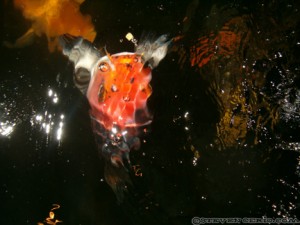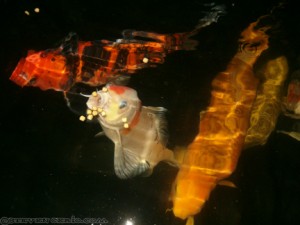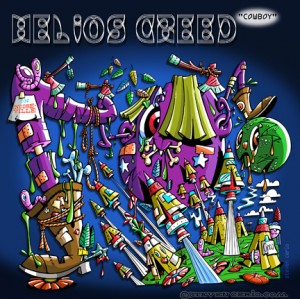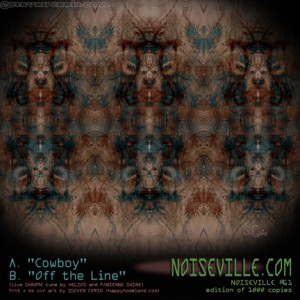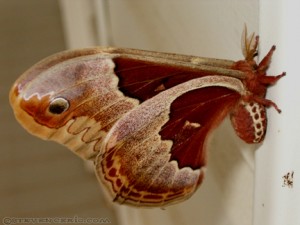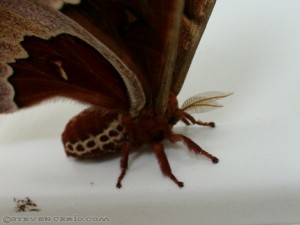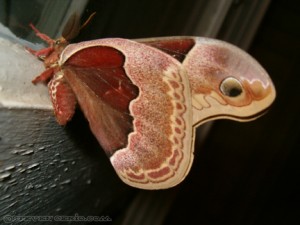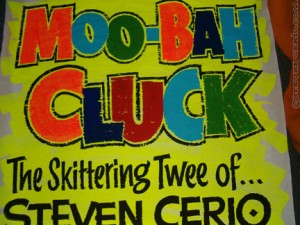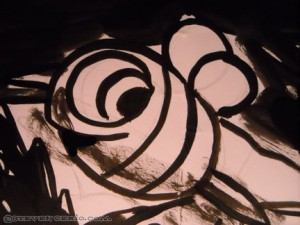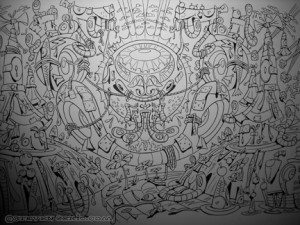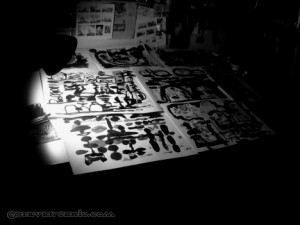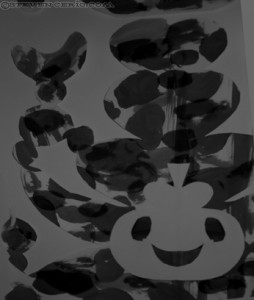Feeding koi in the dark. Look at those big gulping mouths.
Year: 2010
Interview with Storm Thorgerson- Seconds #46 (1998)
STORM THORGERSON
Album cover artist who founded
the design studio known as
Hipgnosis
By Steven Cerio
Recording technology with its resulting media – wax-covered cylinders, shellac discs, vinyl, wire, tape, compact discs, and computer chips – has accompanied us on the long hayride from the dawn of electricity. Evolving at an even quicker rate has been the packaging of those media, especially the record album, replete with glorious covers and gatefold sleeves. As wax and plastic gave way to digital, we found ourselves dealing with miniaturized versions of ‘our beloved album form tucked inside polystyrene (oh sorry, “jewel”) cases. But just as the alarmingly brittle 78 was transformed into a sturdy disc, the CD case will no doubt accept the hand of transformation as well. Packaging is always changing. And whenever “industry standards” get in the way of art, HIPGNOSIS reinvents them.
Hipgnosis design studio was the brainchild of STORM THORGERSON, a graphic designer specializing in creative photography. Being a former classmate of Roger Waters and a close friend of Syd Barrett, Storm was asked to create the mystical collage gracing the cover of Pink Floyd’s 1968 psychedelic masterstroke A Saucer Full Of Secrets — heralding the birth of Hipgnosis. Since then Storm has designed memorable sleeves for Syd Barrett, Led Zeppelin, Genesis, Paul McCartney, Peter Gabriel, The Police, Black Sabbath, and many others as well as continuing to create all of Pink Floyd’s ubiquitous imagery.
The works Hipgnosis has produced are the closest things to graphic miracles that the music business has, even when juxtaposed against the present visual technology here in a decade when anyone with a Mac fancies oneself a designer. In the Seventies, when the most the consumer could expect from the packaging of their newest aural delight was perhaps a somber, grainy photo of the artist in an obvious state of deep introspection, wishing for the positive fruition of worldly concerns, Hipgnosis brought you the gatefold beauty of Houses Of The Holy and Dark Side of The Moon. When in the Eighties the ugly visage of MTV poked its Clearasil-laden forehead over the horizon and Punk had finally grown redundant, Storm gave you unabashedly skillful Surrealist renderings, so painstakingly executed and conceptualized that their meanings and methodology would be discussed in-depth by a long line of longhairs over cheap beers and nickel bags for years to come. When Punk’s wholesome cousin New Wave came to town, the keepers of the graphic torch brought forth black-and-white photos of overdressed combos. Those covers were in general the cover-art counterpart to moussed hair, but with that added touch of grainy insolence. Hipgnosis turned away in ocular disgust, creating Animals, yet another classic Floyd design.
Storm has also authored a shelf-full of books, including Classic Covers 0f The Sixties and three collections of his own work – The Goodbye Look, Mind Over Matter, and Walk Away René – as well as founding and editing the seminal Album Cover Album series, volumes one through seven. The latter have become standard reference books for any Rock enthusiast, to be placed coolly beside the obligatory dog-eared copy of Carburetor Dung or The Trouser Press Record Guide.
To date Storm has been nominated for seven Grammy’s, been honored by Billboard and MTV and, if it matters to you, has five covers that rate amongst Rolling Stone’s top ten covers of all time. Hipgnosis a.k.a. Storm Thorgerson is among a tiny handful of artists capable of receiving mainstream, tux wearing critical acclaim and its benefits while maintaining their vision and integrity.
Storm’s most recent project is the sizable Mind Over Matter, a book written to celebrate thirty years of Pink Floyd artwork. Beginning with the inception of A Saucerful Of Secrets, continuing through the trials and tribulations of a working relationship with Syd Barrett, and then on into the present high budget days of the band, Mind Over Matter is a definite must for Floyd fans as well as art aficionados. This book includes never-before-seen roughs, rejects and variations accompanied by user-friendly texts dealing with method, technique, relevance, meaning, passion and business. The reproductions are of an excruciatingly high quality, with images appealing, even to the Floyd-impaired. The book’s pages drip with enough psychedelic delusion to scramble DNA at a passing glance. Reproductions of gatefolds aplenty and the ghosts of crackling vinyl will have every baby boomer and love child separating weed from stash in a nervous rush.
Mind Over Matter is a busload of high-art forms, as only the higher forms can pack in both bliss and chromosomal liquidation by withstanding the poking and prodding of Art news intellectuals and buzzing American study-hall verbosity alike. Which, after all, is the true test of a form which hopes to survive geological time.
SECONDS: You began working with Floyd with Piper At The Gates Of Dawn, correct?
THORGERSON: No.
SECONDS: I thought I read that in Mind Over Matter.
THORGERSON: I didn’t do it but I put it in the beginning of Mind Over Matter because it was the beginning of the Floyd — but I do stress it is not mine.
SECONDS: A Saucerful Of Secrets then?
THORGERSON: Yes, that’s where I started. Actually, they can’t find the photographer who did Piper.
SECONDS: How much of the Saucerful concept was Floyd and how much was you?
THORGERSON: God, I can’t remember – dear dear, it was so long ago – I would say it came out of conversations we had with the band, who did not want the record company to do the cover. This may be because they were already moving away from the idea of psychedelic portraiture or pictures of the band in frilly colorful shirts. You have to remember things were changing then. For the first twelve months of the Floyd’s existence in public, they did wear some pretty colorful gear but I think by the time of their second year they were not as interested as they had been. They actually asked a friend to do it. Because I knew them and had grown up with them, there wasn’t a need for a great deal of discussion. So the cover is an attempt to represent things that the band was interested in, collectively and individually, presented in a manner that was commensurate with the music. Swirly, blurred edges into red astrology/Dr. Strange images merging into images, a million miles away from certain pharmaceutical experiences. Beginning with Saucerful, they were beginning to experiment with more extended pieces and the music would cascade and change from thing into thing.
SECONDS: How much was Syd Barrett involved in that album? At that point, he supposedly conceptualized everything and the rest of the band just followed along.
THORGERSON: No, this is when they got rid of him. He’s not on the whole record. In his descent – or ascent, whichever way you look at it – it was a beyond-the-zone-of-collective reality; wherever he went was not easy for others to go. Probably one would not want to go there. So it got to a point where they couldn’t communicate very well, neither them to him or him to them. It was quite serious. Not only was he their friend, he was also the main creative source – so what was the point of getting rid of him? It would make no artistic or business sense. They talked to me because I knew Syd but I couldn’t really help them with all this psychology stuff. I was more useful in doing covers for them than I was in helping them deal with Syd. It was very sad because they had no desire to get rid of him and he had no desire to leave but for whatever reasons – they were complex reasons that are not totally relevant to me and this interview.
SECONDS: Anything to the myths of him popping up now and then?
THORGERSON: Oh yeah. The cover of Madcap Laughs, his solo album, was done by me. He was fine there – or relatively fine. Orbiting and fluctuating between strange moods of hyperactivity, enthusiasm and remoteness. It got worse when the record company did a double album re-releasing Madcap and his second album, Barrett, together. That’s about 1970.
SECONDS: That’s the cover you did by piecing together old photographs?
THORGERSON: Yeah. I thought it was better I did it than somebody else. I would have liked to have done it with Syd but he wouldn’t even talk to me. He locked himself in his room. We saw him about five years later at Abbey Road during Wish You Were Here and that was really strange. After that, we never saw him again. What can you do? He’s in a state that is not easily approachable. It’s very sad.
SECONDS: Do you see yourself as part of the history Psychedelia?
THORGERSON: You can answer the question better than me. [laughs] I think Saucerful was sort of quasi-psychedelic. There are psychedelic mental processes that go on in the work, if you like. Psychedelic as a manner has to do with strong colors and patterns and a blurring of boundaries in between things. We did a bit of it in the repackaging of Saucerful and Meddle recently but it’s very minor. For the most part, I don’t think so. The cow is hardly psychedelic. It’s just a goddamn cow, isn’t it? What can be more un-psychedelic? Ummagumma is quite layered and narcotic but I don’t think it’s psychedelic.
SECONDS: I remember in high school staring at covers like Led Zeppelin’s Presence and trying to figure them out. I’m still trying. Are you trying to cause confusion?
THORGERSON: I think my imagery provokes inquiry but it’s quite friendly. Sometimes it’s criticized as being pretentious or over-meaningful but I never thought it was. The man on fire shaking hands on Wish You Were Here is a man on fire shaking hands. He was on fire for real, too! It was just an odd thought, but you can read all sorts of meanings into that – and people do – but it’s not there to be meaningful. I’m answering your question in an ambiguous fashion because that’s what it is. There is art that’s over-pretentious and over-symbolic. And it’s trying to pretend to be something way beyond what it is – but I don’t think we did that. The pig over the power station was just because the album was called Animals and they were going to use a pig in the show. It doesn’t have any deeper meaning but you could certainly give it some if you wanted to. I like to provoke you a bit but I don’t think it’s the reason d’etre. The statues for Division Bell do have resonances but I also think they’re just elegant sculptures. I hope people enjoy them for being an elegant shape.
SECONDS: For the beds on the cover of A Momentary Lapse Of Reason, most people would just have had a painting of it but you went out and used real beds!
THORGERSON: That was a nightmare. Those beds are real. There’s about seven hundred and fifty of them. And you know what? They’re wrought iron – they’re heavy as shit! In a desire to make it a real art installation, we got the beds and took them down to the beach. The trucks held them at the top of the cliff and we had a bout thirty people carry them down by hand. It took us about six hours to put the beds out. It looked great – then it rained and you couldn’t see anything! So we had to cancel the shoot and take all seven hundred and fifty back up the cliff, put them back in the lorry, wait two weeks, and do it again. At that point, I wondered if I was stark raving mad. I said to David Gilmour when we were doing it, “Nobody’s going to believe we were this fucking stupid.” I wanted it to have a “My God!” quality when you look at it whereas I didn’t want anyone to think that about Division Bell. I just wanted people to enjoy the sculptures, which are based on a psychological drawing called “The Candlesticks.” You have a picture of a candlestick, which is actually made up of two profile heads, and your eyes are supposed to fluctuate between the two. The two heads on Division Bell are talking profile-to-profile and together make one head looking at you. That’s the important thing, not “Oh my God, how did they do this?” Division Bell was difficult to do for other reasons – the band didn’t like it at first. That’s ironic because it was supposed to be a picture about communication and we couldn’t even communicate it to the fucking band! The other problem was that it had to be done in the depths of winter, and in England January is enough to freeze the bollocks off a monkey. It’s like when they do a film and have lots of people in some freezing place and it drives people completely mental. Not withstanding that, I think it’s my best work for the Floyd and that’s why it’s on the front of the book.
SECONDS: I’ve always thought you were heavily influenced by film.
THORGERSON: I went to film school, you see. A lot of my stuff has narrative edges. I wear two hats, a film hat and a design hat. See, I also make the films for the Floyd. I’ve made concert films, videos, documentaries and commercials. The last commercial we did for the Floyd was completely incomprehensible. It was used in England to advertise the back catalog. It was about an art gallery that had the Floyd covers hung in it. People were talking about the artwork but they were talking in Icelandic, Hindi and Japanese, I don’t think anybody in England could understand it at all but it made us laugh.
SECONDS: Houses Of The Holy definitely has a cinematic element as well.
THORGERSON: It does. It partly comes from a book, Childhood’s End, by Arthur C. Clarke. In this book, the aliens arrive and hang over the cities in large ships – Independence Day ripped the idea off, I presume. The end of Childhood’s End is about children and it seemed the book had a resonance similar to Zeppelin. I try not to blatantly borrow. I think only once I used an old photo. We always do our own photos and illustrations. It’s all new stuff.
SECONDS: The stone formations on Houses Of The Holy are natural?
THORGERSON: They’re in Ireland, and they seemed to be the Celtic connection that Zeppelin had. The black object on Presence is supposed to represent the ultimate power. I think Zeppelin were the most powerful band that ever was.
SECONDS: The one cover of yours I never understood was And Then There Were Three by Genesis.
THORGERSON: That one’s a failure.
SECONDS: What were you going for?
THORGERSON: We were trying to tell a story by the traces left by the light trails. It was a torch, a car, and a man with a cigarette. The band was losing members and there were only three of them left. The lyrics of the songs were about comings and goings and we tried to describe this in photographic terms by using time-lapse. So there’s a car going off to one side and then the guy gets out of the car, walks over to the front of it, and lights a cigarette. But as he walks he uses a torch and the car he was in leaves. There’s a trail left by the car, a trail left by him as he’s walking and then he lights a cigarette, which on the cover is where there’s a flash of his face.
SECONDS: Weren’t there two different versions of the cover of UFO‘s Force It?
THORGERSON: There were, that’s right, because the Americans regarded it as too provocative.
SECONDS: Right, the two women.
THORGERSON: I think we sprayed them with a white airbrush to reduce their presence. Houses Of The Holy was banned in Midwestem states, Flash was banned in Spain, Scorpions’ Love Drive was banned in several countries
SECONDS: Love Drive – was that the one with the girl and the car?
THORGERSON: Not exactly the most politically correct scene you’ve ever seen. I thought it was funny but women read a different inflection into it now.
SECONDS: Did you also do Animal Magnetism by The Scorpions?
THORGERSON: Yeah. .
SECONDS: I love that cover!
THORGERSON: That one was funny.
SECONDS: The girl drinking the can of Heineken and the guy with the Doberman Pincher – I could never figure that one out.
THORGERSON: I don’t think we figured it out either. We just knew there was something rude somewhere.
SECONDS: Do you miss the gatefold LP?
THORGERSON: I think so. Gatefold LPs were a place to exercise our magic. I’m sure the punters miss them as well. Its just CDs are so much easier to store, maintain and utilize. As a designer, the CD being physically smaller presents some problems. But designers have to pay the rent and eat, so they adapt and make the best of it. The packaging is more manipulatable with CD’s. There’s more things you can do because it’s cheaper. I think Pulse was really fun. My red light is still flashing. It’s like talking to me and saying, “Hi.”
SECONDS: You’ve done some really elaborate packaging design. Have you ever had a problem with funding from the labels?
THORGERSON: No, it’s usually all discussed beforehand. There will be times when, as we say in England, you “come a cropper” – a fuck-up. One of the best pieces of packaging we developed is the “lugless box” for CDs With your jewel box, you know how often you have the little things that hold the booklet in and sometimes you can’t get the booklet in and out with destroying it? There used to be up to six “lugs” to hold the book in but I got rid of four of them, so there’s only two and It’s easy to put the book in and out.
SECONDS: So they changed it at the factory then.
THORGERSON: Yes, they changed the mold. So you can break the mold. I don’t know if they’ve done it in the States but all the Floyd CDs in Europe have the least amount of lugs.
SECONDS: Do you consider yourself a better art director, designer, or photographer?
THORGERSON: It’s a bit of all those, isn’t it? I was an amateur photographer. I was interested in camera and lens because of the film side of it and also because I can’t draw. Some people call me an art director, but I don’t know if I’d say that. I’m a designer in the sense of devising what it is. Division Bell is my idea but the statues are actually designed very well by a sculptor I hired named Keith Breeden.
SECONDS: You seem to use more photographs than paintings.
THORGERSON: That’s because I can’t paint! [laughs]
SECONDS: Do you not enjoy painters?
THORGERSON: Oh, I do very much. It’s just something I can’t do and if you can’t do, you adapt.
SECONDS: Magritte influences your work. Are you influenced by any of the old Surrealists?
THORGERSON: I wouldn’t know, really. Our first book from 1978 was called Walk Away René because we thought we’d left that influence behind but people used to say we were Surrealist anyway. I think our stuff isn’t as odd as his. I don’t think the cow, Ummagumma, or Division Bell is remotely like Magritte.
SECONDS: You seem to have avoided the retro-styles.
THORGERSON: That’s not entirely true. I like Animals because the building is a very Art Deco building. Presence is very much about nostalgia, they’re very Forties and Fifties photos. At the time, I was fed up with people using Forties and Fifties photos so I said, “I’m going to take some Forties and Fifties photos and fuck with them.” The black object is interpolating itself and suggesting that Zeppelin has spread across the time. It’s also a cynical artistic joke about people that were using dated photos from a library and calling it a “design.”
SECONDS: Have you ever designed any Jazz covers?
THORGERSON: Brand X was kind of Jazzy. I did a nice cover for John McLaughlin and then did a lousy cover for him and his two friends Al DiMeola and Paco DeLucia. I actually think Jazz covers are really good. Maybe people think what I do would not be suitable for Jazz. When you work freelance, you work when somebody rings you up. There’s so many bands I’d like to work with but you can’t pick and choose easily. A lot of it is luck. We worked for Led Zeppelin because they saw a cover we did for Wishbone Ash that they really liked. They rang up and said, “Did you guys do that?”
SECONDS: How do you feel about the art Roger Dean did for Yes?
THORGERSON: Tricky question. [Iaughs]
SECONDS: How often do you get exactly what you want visually with a design?
THORGERSON: Rarely! The imagination is unfettered, so you can imagine great landscapes full of strange beings but it’s hard to affix it in reality. But if you were to ask me how many of my pieces am I satisfied with, my answer would be a lot more now than I was before.” One has a capacity to get too critical. I don’t know whether that’s just my Englishness, but I am quite harsh at times, which is why I tend to feel things didn’t work as well as they might have. One of the pleasures of working for the Floyd was that the majority of the sixteen or so pieces I’ve done for them were okay. I was credited here in a newspaper the other day as doing some of the best covers in the Seventies – and some of the worst! [laughs] That’s quite Rock & Roll, really: nothing but extremes.
Interview with Bill Bruford- Seconds #28 (1994)
BILL BRUFORD
MASTER BEATER
Everything you wanted to know about
BILL BRUFORD but were to afraid to ask.
By Steven Cerio
Drummer, percussionist and composer BILL BRUFORD – The answer to the trivia question “Who is the only person to have been in Yes, Genesis, King Crimson?” Master stroker, father of Prog Rock drumming, Bruford left the tinkering over-anxious beat keepers in the dust. For decades his Popeye-like forearms have flailed away, providing the lions share of sound while his more glamorous band-mates have always snapped up the spotlight. Bruford has gone beyond mere percussive beat keeping—he’s a musician capable of propelling the eccentric time signatures of Prog Rock explorations with inescapably powerful snare beats and a smoothness of the greats like Buddy Rich, Elvin Jones and Gene Krupa.
Starting off at the throne of Yes, Bruford made a name for himself as an aggressive Art Rock proto-Fusion drummer who paved the way for other Prog drummers like Terry Bozzio, Neil Pert, and Billy Cobham. He left Yes to drown in their topographic ocean as he switched his allegiances to Fripp’s revitalized King Crimson. Churning out record after record packed to the lid with severe rhythmic contrasts and harmonic dissonance, Crimson tore up the flowing effervescence of the docile Prog bands of the time. Their music created the illusion of chaos through its frequent atonality and compositional complexity.
After the demise of King Crimson, Bruford had more beats up his sleeve. He helped out National Health, Genesis, and others. Then he formed a band under his own name, a unit that stole the aggression of Punk to blend with the finesse of Jazz. With the six-string sorcery of Allan Holdsworth and the bass wizardry of Jeff Berlin, Bruford would remain untamed until their quick demise after their fourth LP.
Following stints with UK and Patrick Moraz, he found himself faced with the rebirth of King Crimson. He was surrounded by Tony Levin and Adrian Belew as well as the ever-present Victorian aura of Fripp. The recorded results were the triplet of Discipline, Beat, and Three Of A Perfect Pair. This project was the closest Bruford has come to Pop music, mainly because the song lengths stayed under eight minutes.
Then there was the birth of his present group Earthworks, where Bruford and crew investigate the jazz of the dirty Americans. With this project, Bruford revitalized drumming and percussion, pulling drummers out of the shadows of the Marshall stacks once again. Armed now with a saxophone player, Earthworks explores the sultry side of music in these days of Grunge and jangly bullshit, all while plans for another King Crimson are being prepared.
SECONDS: Do you consider yourself a Rock drummer?
BRUFORD: Well I don’t. The whole Rock vs. Jazz thing is a totally meaningless conversation that is really only best had between marketing departments at record labels and record store owners. Anybody who knows anything about music knows that it is an entirely gratuitous and passé conversation. The best of Rock has the spirit of Jazz in it and the best of Jazz often has the best attributes of Rock in it. You try to play good music. You try to keep the best elements of both things. If you call me jazz, you condemn me to no record sales. On the other hand, I cannot call myself Rock because I don’t have a singer. So it’s a Jazz group. When I play in Earthworks I’m a Jazz drummer. Let’s keep it simple. I’m Bill and I play with Django and Ian. Then I play over here with Robert Fripp and Tony Levin and that’s a different thing. It’s not Rock or Jazz, its different people who walk through the door.
SECONDS: King Crimson was just a thing unto itself.
BRUFORD: It was. It has had elements of Jazz in it and elements of European improvising and even little bits of Classical music occasionally pop up once in a while. It’s all elements of everything. At the end of the day, you’re trying to fashion a group sound that sounds different from anybody else.
SECONDS: How much improvisation do you do?
BRUFORD: In theory, you would not be able to tell when the written music finishes and the improvising music starts. I’m sure of course you can. We have kicking off points like all Jazz groups do. We start somewhere and then stuff happens. On this live Earthworks CD, the second half of “Emotional Shirt,” the whole of “Bridge Of Inhibition,” and large portions of “All Heaven Broke Loose” are improvised. “Pilgrims Way” in entirely written.
SECONDS: On the new record, you’re using chordal drums.
BRUFORD: That’s a way of trying to describe the fact that the instrument I’m using is a hybrid. It plays drums and keyboards at the same time. That satisfies my fantasies of being a keyboard player. I can assign to any pad at any time any note or combination of notes and samples and add an analog sound anytime.
SECONDS: With King Crimson, you were saying how you formed the drum set after you arranged the band.
BRUFORD: That’s absolutely true. In King Crimson, the music was arrived at in another way, and it turned out what we then needed was this instrument and that instrument. With Earthworks, I had an instrument that you could almost do solo concerts on, though I’d never want to go down that route. This instrument if you configured a rhythmic and percussive scenario — it was very interesting. You could just take it to other musicians and say I’m going to do this and you guys can throw on top of mine and harmonize a bit. It won’t sound like regular Jazz it will sound different.
SECONDS: It seems this newer music has more of a calming effect, as opposed to the Bruford albums which seemed very aggressive.
BRUFORD: You get a bit more measured as you get older, a bit more thoughtful, maybe. The guys I’m playing with are much better musicians. Nobody wants to hear constant tension all the time. I like playing slow. Sometimes playing slow is harder than playing fast.
SECONDS: What kinds of people are coming to your shows now?
BRUFORD: A mixture, Earthworks has played in the States three or four times now and its sort of getting its own audience. There’s King Crimson fans who are being brought into Jazz. There’s a number of young Rock guys. Because I’m supposed to be a Rock drummer but yet have a fascination with Jazz, that encourages young Americans to come over to Jazz, too. I’m in a position of being able to lead people and show them things. There’s a lot of young Rockheads who say, “I don’t like Jazz but I like Earthworks.” You hear that all the time. You realize they never heard any Jazz ever and it’s all based on prejudice. After two hours of Earthworks, they like Jazz.
SECONDS: How did you like working with a percussionist early on in King Crimson?
BRUFORD: That would be Jamie Muir way back when. He was a very interesting man. He taught me lots about music and life in general. I have worked with two drummers quite a bit-like with Phil Collins in Genesis and Alan White in Yes. We have a new King Crimson starting up too, which is going to have two drummers.
SECONDS: What’s the line-up for this King Crimson?
BRUFORD: The 80s King Crimson plus a Stick player and another drummer. It’s a very big sounding group. It’s huge. I don’t think it’s loud, but it’ s very dense and dark.
SECONDS: With Fripp, he’s always come across as the dictator of the band. How does he express his ideas?
BRUFORD: It’ s a lot less than you think. In common with Miles Davis, Robert picks interesting guys. That’ s the entire art of bandleading — picking the right people. If you pick merely interesting people, they’ll make one good album and break up. If you pick the interesting and right people, they’ll make several albums. All Robert does is pick four guys and shut the door and let them figure out their own problems. You’re in the room together and you just have to find a way to make it work. You just forget any ideas you may have had about how it should be or how it was in the past or how it could be. You come with a pair of sticks and an empty brain. He doesn’t in any way give orders, although a certain amount of the current music is written from his guitar. Again, it’ s not the type of band you write a tune for. You find the music in the rehearsal room.
SECONDS: I heard Fripp said something about John Wetton overplaying a lot on the older stuff, and when you did the CD reissues Fripp was thinking about turning down the bass. Is that true?
BRUFORD: I think that’ s very true. John did overplay. John got noisier and noisier as life went on and things became more hysterical until it reached a peak in Asia. By the time he got to UK with me in 1977, he was playing real loud, very loud. That almost killed UK because Holdsworth couldn’t bear him. John did start to play too loud, which is a shame, because he was an extremely hip bass player for a while.
SECONDS: Was that UK project planned as a Rock supergroup?
BRUFORD: That supergroup thing was all kind of nonsense. It was planned that if a couple of Jazz guys and a couple of Pop guys could somehow meet then it would be an interesting album. It was interesting people in a room, but the wrong people. So they made the one good album and they fell apart. It was a good album, I even like it.
SECONDS: Are there any records that you have a problem with?
BRUFORD: The only one I actively hate is the Yes Union record. I thought that was a terrible record. Absolutely awful, an embarrassing record. It cost way too much money. There was no direction at all. It was just a record company thing where they were screwing the band rotten.
SECONDS: Any egos colliding?
BRUFORD: All egos colliding. It was the most awful album to make. It sounds terrible, too. It was put through every conceivable device and computer to try to do something with it. It’ s a complete testimony to the idea that the more money you spend on something, the better it will get. That’s absolutely wrong. The more money you spend, the worse it will get. They threw money and technology at it and it got worse and worse. That’ s the record I have trouble with, but I don’t go around listening to the old records. It’ s like a photo album. You don’t really want to see a photo of you when you were seventeen, right? you looked stupid. Sure, so I looked stupid. That’s what it is to listen to my records.
SECONDS: Any large egos you had to deal with other than Wetton?
BRUFORD: Singers are always a special case unto themselves. All musicians in a band will acknowledge that the singer will be your problem. Singers have to have problems. They have to have throat problems and anxiety attacks. They’re the people who need the audience to clap. Drummers have the least problems. Drummers never have any problems on the whole because the problems they have they keep quiet about. Why? Because there’s a million drummers. Who needs you in the band if you have a problem? The singer – he’ s the guy who’ s the golden thing to the record companies. We all bow and scrape for singers, but we can dump the bass player and drummer any day. The rhythm section is always the first to go. That applies to all groups.
SECONDS: Is it fun for you to be up front?
BRUFORD: It’s absolutely great. It’s fun to get out and about. I love seeing the whites of an audience’s eyes instead of being stuck in back and seeing John Wetton’ s ass. Life for me is a series of asses that I’m behind. Adrian’s got a very nice ass, slim. John Weston’s is fat. Jon Anderson’s is very small. Nice legs, lousy ass. It’ s a series of asses.
SECONDS: I’m sure you’ve been offered a lot of interesting gigs. Are there any interesting ones you decided to turn down?
BRUFORD: I don’t think so. I always accepted whatever came my way. People haven’t offered me strange gigs. Generally, my phone doesn’t ring at all. It’s assumed I’m some kind of specialist. The minute you say you’re a composer or a bandleader your phone stops ringing; you’re on your own at that point. That happened to me very much. People think you’re too expensive or too busy or you want to play in 15/8 or something, none of which may be true. Maybe I’m extremely cheap and dying to play in 4/4 but nobody takes the time to find out. Most of the stuff we’ve done has been self-created. If you want to hear the drums played a certain way like I do, you’re forced to form your own band.
SECONDS: The Bruford Tapes is your most aggressive, violent record
BRUFORD: It is. It’s very tense. A very live album, not mixed, just straight to two track. When l hear that stuff, it’ s tired. The musicians are tired. Their eyeballs are out on stalks. It’ s two months worth of a heat wave down by Oklahoma, and often doing two shows a night. Four hundred miles a day, two shows a night, very hot temperatures and the music is tired. You could tell when musicians are tired and how that manifests itself is incredible aggression. You’re willing to kill the promoter, you’re willing to kill the booking agent, all you want to do is go home. That’ s my memory of those times. I’ve come in and started in New York and ended up in LA exhausted playing at the Roxy or something. Again, five nights, two shows a night, an hour-and-a-half each time, sound check as well, and at the end of it you’ re just so tired. That doesn’t mean the music gets slow – the music gets wild. It was a road band. I like The Bruford Tapes for that reason. The Earthworks live CD I also like for exactly the same reason. Again, no mixing, straight to two-track tape. I like it much more because the band hadn’t done nearly so much road work and was not nearly so exhausted and is a little bit more mature and is still capable of observing silence on the stage and playing with space a little bit.
SECONDS: What are some of your influences?
BRUFORD: Early on, I grew up with Jazz. Grew up through the 60s in England with all the great American Jazz drummers. We used to import albums from the Riverside label in California. I grew up therefore with Charlie Persip and Max Roach and all the big drummers – Art Blakely, Philly Joe Jones and so forth. That’ s where I learned my drums. Then The Beatles came and The Rolling Stones and we listened to those albums but we didn’t like those albums as much as we liked Monk. We had a huge stack of Jazz and a little bit of Rock. I’m the only guy I know who never bought a Beatles record. Now I see it, but then I couldn’t see it. I could only understand Jazz. We started a group in 1968 and l started playing Jazz in Yes really. I didn’t know it wasn’t going to be a Jazz group. For what I’m listening to now, everybody and everything. Being a professional drummer, the ear goes up the minute I hear rhythm anywhere. I can’t say I’m in a club. I’m not in a post-Nirvana club. I’m not in an alternative music club. I’m not in a trance music club. I’m a free agent. I’m trying to be Bill. I’m trying to come up with music that is fresh and particular to me.
SECONDS: What do you think of the trends right now, like Grunge?
BRUFORD: Nothing’s new. It’s all old to me. I’m thrilled the Grunge thing happened because machines were put back in their proper place. Technology really got out of hand in the mid 80s.
You couldn’t even cut a track if there was a human being in the studio. It was all scientists. In London, you could watch the actual physical size of a recording studio be reduced as they wanted less and less human beings in there. The size of the production suite on the other side of the glass was getting bigger and bigger because they wanted more scientists. Now, everything I do is just set up some microphones and let’s play. Thee new King Crimson material I’m doing, six guys in a room, and you play. Just like it used to be, I just played here in New York with the Buddy Rich Big Band. That was amazing. This is a thing that was put together by Neil Peart from Rush. His idea was to get the Buddy Rich Big Band and have all these star drummers play two tunes. We got a guy from Guns N’ Roses. It sounds smoking. This is live. Put the drums up, the horns over there and away you go, you record. The Grunge guys have brought that element back and that’s great.
SECONDS: For a while, everyone was scared of drum machines. Were you feeling threatened around that time?
BRUFORD: I turned left and made my own bands. You can do whatever you want in your own band. There’s no doubt it was a depressing time. I think it’ s much more exciting with real guys.
SECONDS: I read somewhere where you said about King Crimson. “It’s the only gig in the world where I can play in 17/16 and still stay in a decent hotel.”
BRUFORD: You can be treated as a human being, but you’re still allowed to do that stuff. That’s the great advantage of King Crimson. You put those two words together and musicians know they can come in and do some interesting stuff. If you can’t do it in King Crimson, you can’t do it anywhere. It is the place in Rock for a drummer to do something and I’m thrilled to be back. It’s my spiritual home.
Unfinished poster for ‘The Residents’ etc
A detail of a drawing that didn’t turn out too well…so badly in fact I threw it out…but I kept the bee. She’s pretty loveable.

a birthday card
An unfinished version of a poster I’ve been preparing for The Residents. Steve Walters’ Screwball Press will be screen printing it soon. I’ll use 3 or 4 colors on it. Sal Canzonieri wants to use the full color version for the cover of his new book on poster art.
A table covered in ink drying much to slowly on a humid day.

